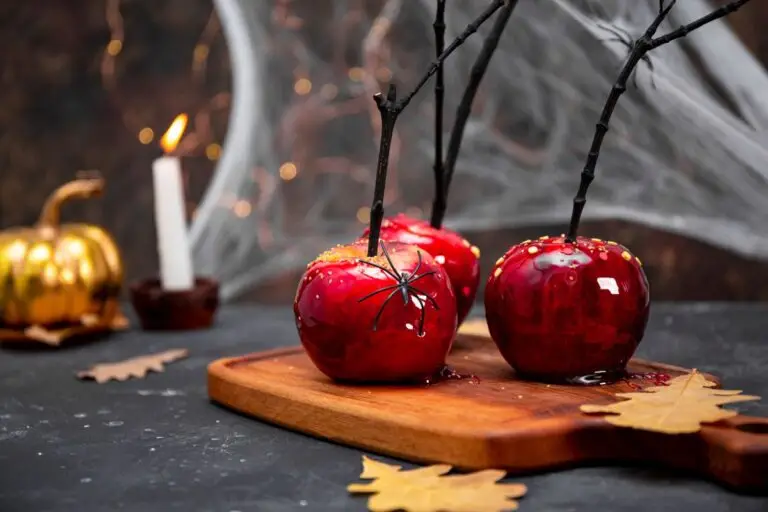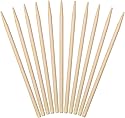This 1923 brown sugar toffee apple recipe delivers glossy, crackly-coated Halloween treats using just brown sugar and water - simpler than modern candy apples. These vintage toffee apples became the signature sweet of Halloween celebrations long before caramel apples existed, with their molasses flavor and glass-like sugar shell making them the original autumn indulgence.
The scent of brown sugar bubbling on the stove hits you first; a deep, caramelized sweetness that clings to kitchen curtains for days. It's the same smell that filled American kitchens in 1923, when these toffee apples were the only autumn treat that mattered.
1923 Halloween Kitchen
In 1923, Halloween fell on a Wednesday evening, and the celebration had a different rhythm than today's candy-fueled extravaganza. Gas lamps flickered on street corners while children in handmade crepe paper costumes roamed neighborhoods, their laughter mixing with the crunch of fallen leaves underfoot.
Halloween parties were planned months in advance, and serious hosts started in August with their copies of Dennison's "Bogie Book," which outlined every decoration, game, and menu detail for a proper celebration. The Beistle Company had just launched its "hair-raising line of party goods" in 1920, bringing mass-produced Halloween decorations to American homes for the first time. Before that, everything from costumes to centerpieces was crafted by hand.
Brown sugar toffee apples reigned as the signature Halloween sweet because caramel apples wouldn't be invented until the 1950s. These glossy treats with their hard sugar shells crackling between teeth became autumn's defining flavor, born from simple brown sugar and water when elaborate ingredients weren't yet common in home kitchens.
Bringing 1923 Halloween to Your Kitchen
There's something so endearing about these 1923 Halloween traditions. They remind us that the best celebrations come from the heart, not the store. Every decoration was handmade, every game required genuine interaction, and every treat was crafted with love and intention.
This Halloween, why not step back in time? Create these homemade toffee apples and taste a piece of 1923. Your family will experience the same magical flavors that made Halloween so special a century ago - proving that some traditions are simply too delicious to forget.

1923 Brown Sugar Toffee Apples
Step back in time with these authentic 1923-style brown sugar taffy apples – a sweet piece of Halloween history that brings the flavors of yesteryear straight to your kitchen. Unlike today’s caramel apples, these vintage toffee apples showcase the natural amber glow of brown sugar, creating a glossy, translucent coating that lets each apple’s natural beauty shine through.
- Total Time: 30-35 minutes
- Yield: 6-8 1x
Ingredients
- 6-8 small, firm apples (such as Gala or Granny Smith)
- Wooden skewers or popsicle sticks
- 2 cups light brown sugar, packed
- 1/2 cup water
- 1 tablespoon lemon juice
- Parchment paper (for setting apples)
Instructions
- Prepare Apples:
Wash and dry the apples thoroughly. Remove the stems and insert a wooden skewer or popsicle stick into the top of each apple. Set aside. - Prepare Work Surface:
Line a baking sheet with oil or parchment paper to prevent sticking. - Make the Candy Coating:
In a medium saucepan, combine the brown sugar and water. Stir to dissolve the sugar. Bring to a gentle boil over medium heat, without stirring, until the mixture reaches the “soft crack” stage (270–290°F / 132–143°C) on a candy thermometer. The syrup should form thin threads that are brittle when dropped into cold water (this replaces the old-fashioned “thread” test). - Finish the Syrup:
Remove the pan from heat as soon as it reaches the correct temperature. Carefully stir in the lemon juice. - Coat the Apples:
Working quickly (the syrup hardens as it cools), dip each apple into the hot syrup, turning to coat evenly. Let excess syrup drip off, then place each coated apple on the prepared tray. - Cool and Harden:
Allow the coated apples to sit at room temperature until the candy shell is firm and fully cooled. - Serve and Enjoy!
Enjoy these nostalgic taffy apples the same day for the best texture.
Notes
If you don’t have a candy thermometer, test the syrup by dropping a small amount into a glass of cold water. It should form threads that can be bent slightly before breaking.
- Prep Time: 10-15 minutes
- Cook Time: 10 minutes
- Category: Holiday
- Method: Stovetop
- Cuisine: American
Nutrition
- Serving Size: 1 apple
- Calories: 210
- Sugar: 50g
- Carbohydrates: 54g
- Fiber: 3g
Why This Vintage Toffee Apple Recipe Works
How to Make Perfect Brown Sugar Toffee Apples
Recipe Variations
Frequently Asked Questions
These toffee apples are best made the same day of your party, as the sugar coating attracts moisture and becomes sticky after 24 hours. Make them the morning of your event and store in an airtight container at room temperature.
Toffee apples use brown sugar or treacle for a darker, more molasses-flavored coating, while candy apples use white sugar and red food coloring. Both reach the same hard crack temperature, but toffee apples have a deeper, less sweet flavor.
A candy thermometer ensures success, but you can test the syrup by dropping a small amount into cold water - it should form threads that bend slightly before breaking at soft crack stage. This was the testing method used in 1923 kitchens.
Waxy grocery store apples prevent toffee from adhering properly. Scrub apples thoroughly with hot water and dry completely before dipping, or use freshly picked apples from an orchard that haven't been waxed.
Freezing is not recommended because the moisture from thawing will make the sugar coating weep and turn sticky. These treats are meant to be enjoyed fresh within 24 hours of making them.
Make sure apples are completely dry before dipping, and allow the syrup to cool for 1-2 minutes after reaching temperature so bubbles disappear. Dip apples immediately after adding lemon juice while the syrup is still fluid enough to coat smoothly.
Small, firm varieties like Gala, Granny Smith, or Braeburn work perfectly because they hold up under the hot sugar without breaking down. Avoid soft apples like Red Delicious that become mealy.
Yes, toffee apples became established Halloween treats by the 1920s, with the first printed recipes appearing around 1919. They were sold at circuses, boardwalks, and made at home for Halloween parties throughout the decade.
While you can add red food coloring, it will alter the authentic amber-brown color that makes these vintage toffee apples distinctive. The deep brown hue from the sugar itself is part of their 1920s charm
Allow 10-15 minutes at room temperature for the coating to set completely before serving or wrapping. The coating should be hard and glossy, not tacky to the touch.
What Halloween treats do you make from scratch every year? Share your autumn kitchen traditions in the comments below!




0 comments